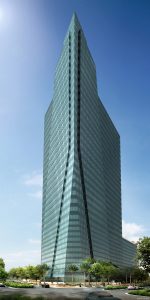MIAMI HERALD – BUSINESS – JULY 2009
A developer has shelled out millions to strengthen the glass walls of his Brickell Avenue office project.
· BY CURTIS MORGAN
After Hurricane Wilma raked Miami four years ago, developer Alan Ojeda picked his way down Brickell Avenue to survey his new apartment project, One Broadway.
Glass from shattered skyscrapers was everywhere, covering streets and One Broadway’s roof and balconies. His high-rise — built to the latest codes with laminated windows designed to endure ”small missiles” like roof gravel — had escaped unscathed.
Still, the surrounding damage troubled Ojeda. Crews spent days shoveling fist-sized shards off the 36-story roof — bigger junk whirling higher than South Florida’s vaunted hurricane coded addresses for high-rises.

Now, with Wilma’s lesson in mind, Ojeda is putting the finishing touches on another new building, 1450 Brickell. His company bills it as the most wind-resistant glass-sided office tower in the nation. In a marketing release, its exterior wall contractor claims it withstood pressure tests in the lab equating to a 327-mph gust.
”The first thing we decided was we needed to protect the building,” said Ojeda, chief executive of Miami-based Rilea Group. “Obviously, the hurricane proved what the code says is not enough.”
In what building experts said appears to be a first in Florida for a commercial tower, the entire 35-story facade is being constructed with ”large missile” impact glass, an upgrade adding millions to the $250 million project. Required for homes but only on the first 30 feet of taller buildings, the glass can withstand strikes from a nine-pound 2-by-4 stud.
There are some questions about the stunning 327-mph wind calculation. The director of the testing lab, A.A. ”Sak” Sakhnovsky, whose Construction Research Laboratory in Miami pioneered testing building designs against the elements, acknowledged that “it’s probably a bit of a stretch.”
But Sakhnovsky also said the building, expected to open early next year, raises the bar on wind resistance.
”It was designed for extremely big loads, probably higher loads than we have ever tested,” he said.
Despite questions from many engineers and building officials after Hurricanes Katrina and Wilma blew out thousands of building windows from Miami to Fort Lauderdale, window codes haven’t changed much since 2005. ”Small missile” windows — tested by firing pea-sized ball bearings at panes — remain the high-rise standard.
”If they are actually using glass that would pass the large-missile test, that’s not something I have seen,” said Tim Reinhold, vice president of engineering for the insurance-industry-supported Institute for Business and Home Safety in Tampa. “To me, that sounds like a very positive step.”
Rick Dixon, executive director of the Florida Building Commission, which revises statewide building codes, said that level of protection typically applies only to facilities considered critical such as hospitals.
To a large degree, Wilma did the worst damage to towers erected before a strengthed 2000 code mandating windows with layers of plastic laminate. Buildings with those, including One Broadway, actually weathered Wilma well.
TOO RISKY
But Wilma was a 100-mph storm, not a major hurricane, and Ojeda decided that what worked in an apartment — built with balconies and concrete block — was too risky for an all-glass, high-end office high-rise.
”You have to look at it in a different way. You have to look at it as a body of glass,” he said. “Small missile is good. But what is better?”
He and his contractors stress they aren’t claiming they’ve built an unbreakable glass fortress that will survive a major hurricane without a window cracked or blown out. There is no way of knowing what might be flying around the next time one hits.
But the building does exceed the nation’s toughest wind code. Ojeda is banking that his investment — the glass added millions, about $30 to $40 a square foot, to curtain wall costs — will pay off for his company and tenants over coming hurricane seasons.
The state has upgraded some window codes since 2005, the Building Commission’s Dixon said — but mainly to reduce water leaks. To address flying debris, the standards for attaching objects like satellite dishes were also substantially increased, he said.
Miami-Dade, whose codes Broward also uses, tweaked the code to require laminated or tempered glass for insulated windows above 30 feet. The change, which went into effect in 2007, is intended to cut down on large flying shards that likely triggered the cascade of breakage in Hurricane Wilma, said Jamie Gascon, chief of product control for Miami-Dade’s building code compliance office.
Gascon said county records show 1450 Brickell’s glass was approved for a small-missile standard but is similar in design to laminates commonly used for large-missile windows.
`CURTAIN WALL’
To handle the glass, Enclos Corp., which designed and installed 1450 Brickell’s exterior or ”curtain wall” — the outer framing system that is a standard construction method for modern glass skyscrapers — also had to beef up everything else.
Bolts are heavier gauge. Aluminum framing is thicker and wider. More silicon is used to hold and seal panes. Anchors that attach the wall to the concrete core, ”we’ve basically had to put them on steroids,” said Lee Steffens, project executive for St. Louis-based Enclos.
While the tougher glass adds a margin for debris, it’s the entire assembly that increases wind resistance, Steffens said. “Your skin can take so much pressure on it, but in the end it’s your skeleton that holds you up.”
The 327-mph mark, Steffens said, came from a standard test that briefly exposes a glass system to pressures 50 percent over design capacity.
But Gascon said county records showed test pressure equated to ”more in the neighborhood” of a still-impressive 220-230 mph.
”There seems to be a clear question as to how they derive that 327,” said Gascon.
The glass also cuts energy costs, Ojeda said.
”Wilma happened. It’s not that it happened when we were kids. It can happen again,” Ojeda said. “If you view things in the long term, you know that if you cut corners, you will wind up paying for it.”







 See More Blogs
See More Blogs
Comments